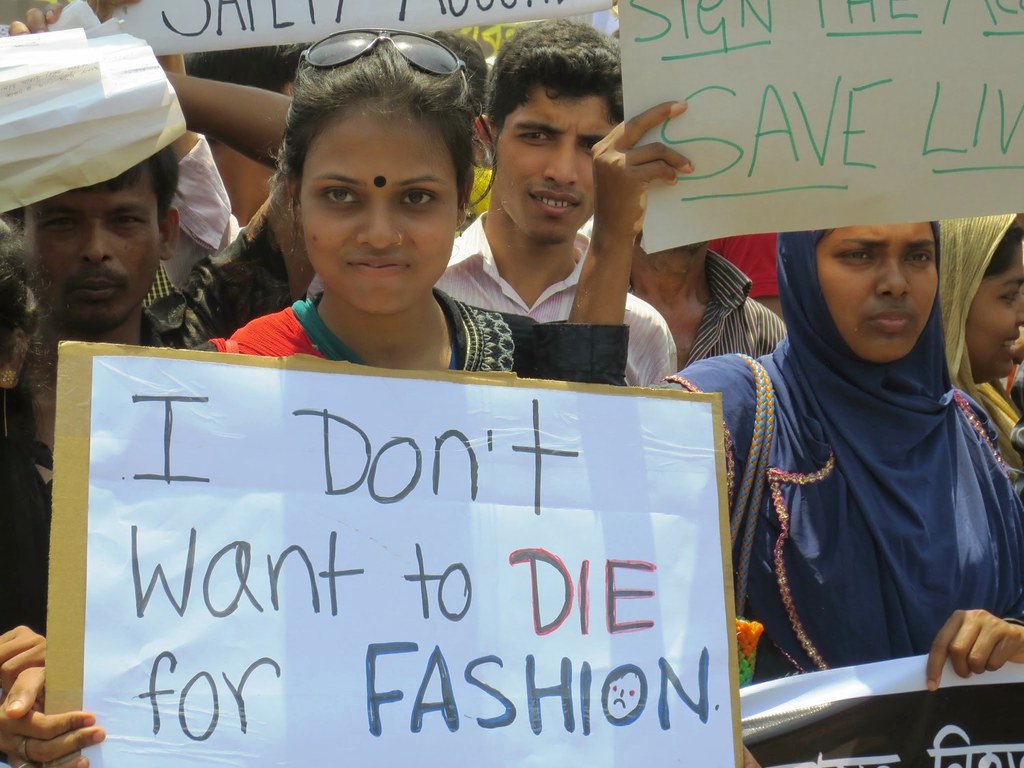Environmental and Human Impacts

A Shift in Sourcing
The demand for cheap denim in the United States has pushed brands like Zara and H&M to source internationally, enabling the detriments of the fast fashion industry to rule. As consumers, we are shielded from information regarding what really goes on during production, and are guided to the cash register by the affordable prices and up to style cuts. We don’t think about the hands that worked tirelessly for little pay, or the environmental costs denim production is having. While many higher end brands and companies create seasonal styles, fast fashion power houses constantly restock, a wasteful process that works to increase customers to buy before the item is no longer available (Mihm 55). We tend to pinpoint denim with the label sewn into the back, but forget the interlocking relationships that occur for jeans to become a consumer product. We don’t think about the inequalities in wages from the people gathering the cotton, to the machine operators, to the investors that turn a blind eye to most of what is going on. We don’t think about how the fabric, zippers, and buttons were sourced from different factories, in order for the company to take advantage of the cheapest labor (38). A 2001 finding shows that Levi’s took an approach similar to the one just mentioned, using a combination of different factories throughout Mexico in order to take advantage of cheap labor (Brooks 38).
Image sourced from WordPress creative commons. Photograph titled “SweatShop Project” by Marissa Orton. Image depicts worker draining indigo dye from denim. The dark blue color stains his skin, revealing the intensive and toxic process of treating the fabric.
A Double Edged Sword
Cheap labor comes at a massive price. The atrocities are usually covered up, but the case of the Rana Plaza garment factory reveals an atrocious instance of abuse that occurs more often than one would think. The garment factory in Bangladesh collapsed causing the deaths of 1,100 people, and leaving another 2,500 people seriously injured (Brooks 38). Yet this is a doubled edged sword as many people rely on the pay from working in garment factories to support themselves and their families.
Sampa Akter, a garment worker from Bangladesh earns 95 dollars a month working at a denim factory. She has been working here for the past 12 years and the money she has earned has enabled her to support herself, her sister, her disabled brother, and their parents. Once covid struck, her factory was forced to close leaving her jobless (NPR). She couldn’t pay rent or her brother’s medical bills, leaving her in the hole financially. This is where the real toxicity lies of this cyclical oppressive system of sweatshops. While these garment factories are giving people jobs, they demand 12 hour shifts and if anything causes them to close, their employees are left jobless. While the law requires the companies to pay severance, many fall through. Additionally, it should be noted that four out of five garment workers are women who most take on these jobs to support their families (npr). Coronavirus has also affected the amount of orders denim companies are placing, many of which have been dealing with their own financial struggles. The President of Bangladesh stated that “orders have dropped by half” due to the global pandemic (npr). While it is easy to just say or think that fast fashion is inherently bad, it is also a reality.
Environmental Concerns
While jeans were originally built to last as the combination of rivets and strong indigo textile proved more durable than canvas, most denim ends up in a landfill after only 1 year (Duraisamy 12). The production of denim alone is proving detrimental for the environment as huge factories produce toxic sludge and push out large amounts of carbon emissions into the atmosphere. Even after the jeans are bought off the rack the energy exerted to wash denim is high as most denim clothing is washed around every two weeks (Duraisamy). While hand washing and drying is preferable, most people don’t hesitate to throw their jeans into the machine. Additionally, the production of denim, from spinning the individual warp threads, to sourcing the cotton, and then finally putting the apparel together, is a tiring and energy consuming process. The toxic byproducts of denim production “are estimated for around 20 percent of industrial pollution in our rivers and land” (Duraisamy).

Taking to the Streets
A year after the Rana Plaza Garment Factory fire, workers took to the streets protesting the atrocities of working in awful conditions. This image depicts a young woman with a sign proclaiming “I don’t want to die for fashion.” Image sourced from WordPress Creative Commons. Image titled “Thousands of garment workers and their unions rally on the one-year anniversary of the Rana Plaza collapse that killed more than 1,100 garment workers“ by Solidarity Center.

A Glimpse Inside
This haunting photograph depicts a man inside a factory in Bangladesh. The black and white image reveals the dimly lit room, exposing the unsafe conditions within these factories. Light peaks through a hole in the roof, and ropes hang from wooden slats that hold up the building. The unsettling architecture works to box in the subject, making him feel small in the space. Image sourced from WordPress creative commons. The author of this photograph is Zoriah.